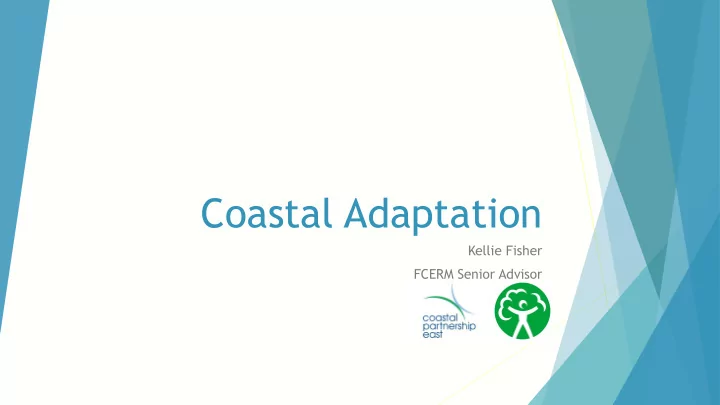

Coastal Adaptation Kellie Fisher FCERM Senior Advisor
Why Adaptation? Adaptation to a changing environment. Coastal change is not new! Traditional defences are a form of adaptation too. Are they always appropriate? Property constructed > property becomes vulnerable > demand for protection > false sense of security > more investment > more risk. SMPs – policy changes. Adaptation = Risk reduction: life, assets, health, economy.
Types of Adaptation Slowing Natural Flood Hard Temporary Elevating Natural Management Asset rollback Defences Defences Property Processes (NFM) Time Floating Purchase and Enabling Low Interest Flood Restricted Property Demolish Development Loans Resilience Use Streamlined Buy and Lease Underwriting Insurance Tourism Stewardship Planning Back Values Payments Scheme Scheme Permission Natural Subsidised Highway Sediment Visualisation Capital Monitoring Maintenance Modifications Sourcing Tools Scheme
Delivery Issues Compensation No clear funding sources Joined up policies and decisions (including planning) Costs of no intervention
Pathfinder Learning Defra funded 15 projects to help communities adapt to a changing coastline. Several reports have been commissioned to review the Pathfinder projects, particularly the largest 5 projects. The economic assessment undertaken as part of the Pathfinder review study showed that adaptation could be economically worthwhile and recommended that there should be opportunities for adaptation to be considered for funding under Grant in Aid.
Trimingham Village located on top of 65m high cliffs Defended from 1970s Highly dynamic shore Access difficulties Cliff area designated as SSSI
Portsmouth University Visit
2010 Easton Bavents 2005 1998 2015 2011
Easton Bavents Ltd
Hemsby & Winterton
Promoting Adaptation Papers, conferences and workshops… Supporting Local Authorities, Defra and National EA colleagues.
Statement of Common Ground Coastal Zone Planning Shared Aims Agreed Approach Endorsed by the Environment Agency
Statement of Common Ground 7 Aims: A holistic and “whole coast” approach will be taken, recognising coastal change is an inevitable part of a dynamic coast. A naturally functioning coastline is desirable in principle, but may not appropriate in every location. To promote innovative approaches such as techniques that enable anticipatory coastal adaptation, removal of affected structures and property roll-back or relocation.
Statement of Common Ground 11 Approaches: Share experience, best practice (including planning policies) and ideas for innovation. Recognise the need to relocate or protect infrastructure likely to be adversely affected by coastal change. Consider adopting policies to facilitate rollback and/or relocation , potentially including local plan site allocations or facilitating ‘enabling’ development.
DEFRA Commissioned two pieces of work: A ‘Quick Scoping Review’ of adaptation by HRWallingford, which will aim to address the following: What strategies, actions and other activities have Local Authorities in England taken, plan or desire to take to adapt to coastal erosion? Specifically: What are the barriers and blockers to adaptation on the ground? How can DEFRA better support local authorities delivering adaptation at the coast? What are the costs and timescales associated with the planned actions? What is the national picture and where are the gaps in knowledge?
DEFRA Commissioned two pieces of work: An Economic Review of funding for adaptation to coastal change, to include: Is there an economic rationale for central government intervention? (An economic exploration, without prejudice to socio-political questions). Exploration of cost-benefit for adaptation, including erosion and permanent flood inundation Funding mechanisms available (including the legalities of using FCERMGiA for adaptation) and their limitations. The economics of FCERM defence decommission and the effects of coastal catch up (where a frontage experiences accelerated erosion as a result of defence removal).
Moving Forwards Acceptance that defence is not always the right option. Making adaptation accessible. Adjusting to the impacts of climate change in an anticipatory manner rather than reactionary. Preparing for changes in SMP policy as well as permanent flood inundation. DEFRA, Environment Agency, Local Authorities (including planners) and MHCLG must work together to find solutions.
Recommend
More recommend